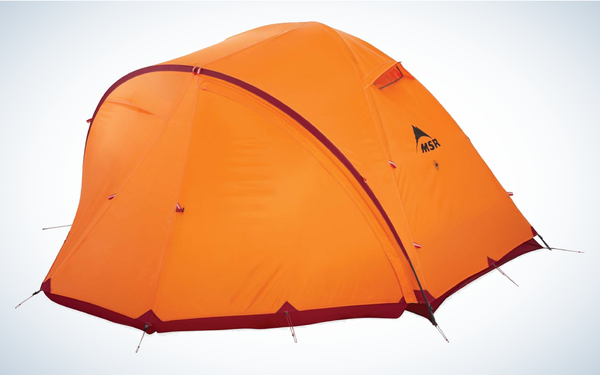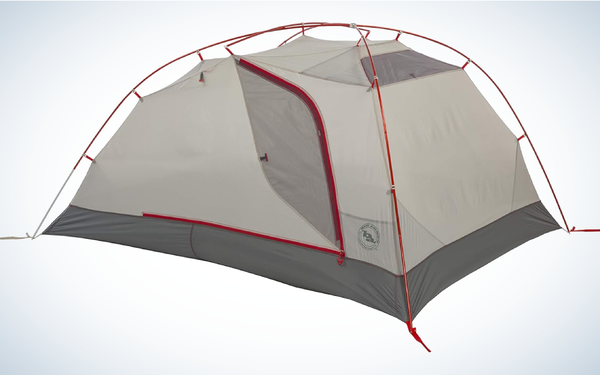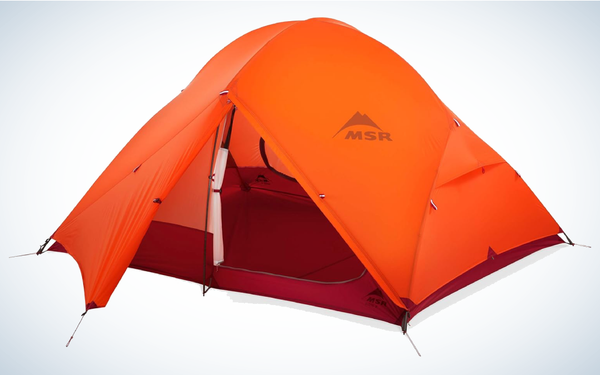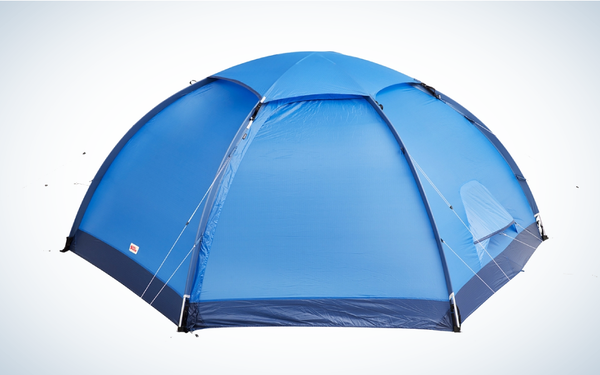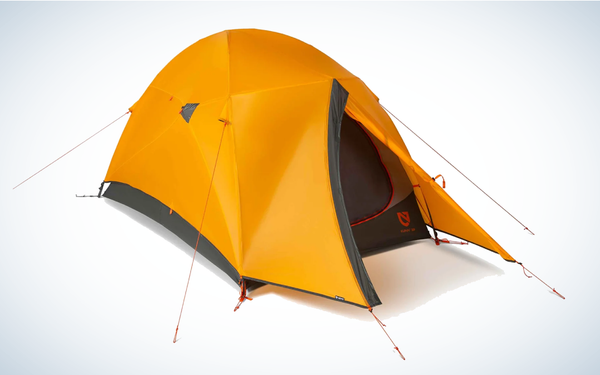



We may earn revenue from the products available on this page and participate in affiliate programs. Learn more ›
As the name suggests, a 4-season tent should function in all four seasons of the year. However, most 4-season tents perform best in colder weather conditions during shoulder seasons and winter camping. Whether you’re looking for a tent that can be used year-round or simply want a tent to use during the winter, we have a recommendation for you.
When looking for a 4 season tent, it’s essential that it can hold in heat, keep out moisture, and ventilate just enough to control interior condensation. Since most 4 season tents have far less mesh material, they tend to be much heavier than other tent options, so keep that in mind if you plan to use it for winter backpacking or ski touring. We tested for you so you can narrow down the best 4 season tent for your next adventure.
Winter camping has been a part of my life since I was a child, and because of that, I’ve had my fair share of miserable nights out in the cold. To choose the best 4-season tents for this article, I combined my prior knowledge and first-hand experience with various shelter options with recent in-field testing. While several higher end brands—like North Face, Mountain Hardwear, and Black Diamond—are ideal for basecamp and expedition tents, I opted for tents that are more versatile and affordable for the average camper.

I’ve used every tent on our list in some capacity, which allowed me to make better comparisons. Beyond testing the tents in winter weather conditions, I had conversations with brands about the designs to help me better understand product materials. I also spoke with fellow campers to see what they liked (or didn’t like) about the tent.
Specs
Pros
Cons
The MSR Remote 2 is the best overall 4-season tent because of its durability, functionality, and overall convenience of being a double-walled free-standing tent. While there is one large hooped vestibule, I liked that it still had two doors and another small vestibule on the other side. The larger vestibule makes storing additional gear outside the tent easy and provides a spacious sheltered area to boil water or put your boots on before braving the cold.

During our first test, there was plenty of room inside the tent for two adults and two dogs. However, I could have done with more interior storage. There are two gear pockets on both sides of the tent, but they are low to the ground and limited in space. Gear lofts on top of the tent would be nice to provide easier access to items.
The materials of the tent held up well in wet, snowy conditions. Even with snow on top of the tent and sticking to the sides, the materials kept us dry. There was some stretch of the fabric, but that’s to be expected with excessive moisture. I struggled to set up the guylines and stake out the tent’s rainfly with the provided stakes, so I’d recommend purchasing a few more.
The only big thing that could be improved with this tent is the condensation buildup inside at night. There is ample ventilation at the top of the tent, but it wasn’t quite enough to allow airflow through the tent to stave off moisture through the night.
Specs
Pros
Cons
If you’re looking for more of a mild winter backpacking tent, the Big Agnes Copper Spur HV2 Expedition should be a top contender. The Copper Spur design is not new to me, as I’ve also used their Copper Spur HV UL2 for summer backpacking trips, and is ranked in our best 2-person tents. The Expedition version has a very similar design, but with different fabric and ventilation system placement. Of all the tents I tested for this article, this was one of the easiest to set up. I was able to get it up in a matter of minutes even when camping alone.
It has a straightforward freestanding tent design with two large vestibules for gear storage. There’s one rainfly vent and several options to stave off some condensation. The ventilation system could still be improved to prevent moisture inside the tent, but it did better than many other tents on our list. While this tent can withstand most moderate winter conditions, it may struggle to withstand extreme winter weather.
Specs
Pros
Cons
The MSR Access 2 is a tent that I can see myself using for most of the year. It is an excellent tent for shoulder seasons, summer high alpine, and moderate winter expeditions. While it is rated as a 4-season tent, the lightweight design makes me skeptical about how well it would hold up in extreme winter weather. However, when appropriately pitched with the guylines, it withstands high winds and heavy snow quite well.

You’ll be hard-pressed to find a more durable ultra-lightweight tent suitable for winter weather than this one. All of the materials are high quality and long-lasting. The ventilation isn’t perfect, but it reduced condensation quite well compared to most of the 4-season tents I’ve tested. It isn’t easy to control moisture while winter camping, so this design managed it exceptionally well. It would be nice to have the option to pitch the inner first, especially if it is raining or snowing, but with such a fast setup, I found it easy to keep things dry.
Specs
Pros
Cons
The Fjallraven Abisko Dome 2 is a 4-season tent that can comfortably be used in all four seasons. The unique dome design offers far more space within the vestibule areas than other tents. While the setup was a bit complicated and confusing at first, it became much faster and more manageable once I set it up a few times. It was confusing because the rainy and the tent’s inner come connected, and the poles go through the sleeves on the outside of the rain fly. This construction is ideal when setting up during precipitation and ensures that the tent’s interior stays dry.

While this may be the heaviest tent on our list, I found it among the most durable. The construction is intended to last a lifetime, and the materials reflect that. Functionally, this tent is roomy, has ample interior storage, and holds up exceptionally well in high winds. Even though the tent is processed using no PFCs, the materials still hold up well in rain and snow. If you’re looking for a tent that can seemingly do it all and is likely to last for years and years of frequent use, the Fjallraven Abisko Dome is an excellent choice.
Specs
Pros
Cons
For all the shoulder season backpackers who want a tent that can extend your trekking season a little bit longer or bring you to new heights in the summer, the Sea to Summit Telos TR2 is my recommendation. It is lightweight, easy to use, and exceptionally functional in various weather conditions. The tension ridge is something I’ve appreciated with other Sea to Summit tents, and I was happy to see it on this one as well. This feature adds more head space inside the tent, making it easier to add or shed layers while sitting down.

The ventilation is excellent for a 3+ season tent in this one, but it will perform better in cooler weather than in the heat of summer. A standout feature of this tent is that you can set up rainfly before the inner, keeping your gear much drier. Several other configurations for the rainfly allow you to make a shade or rain shelter on the go.
Overall, this tent is well-designed and a great value for the price. The materials are lighter, making it slightly less durable than other options, but this is a good choice for folks looking to camp in shoulder seasons more than in the deep winter months.
Specs
Pros
Cons
I can’t say that any of the tents on this list are necessarily budget tents, but I find the Nemo Kunai 2 one of the more affordable options. It is uniquely versatile for all four seasons, and because of that, there is a bit more ventilation than some may desire in the dead of winter. This tent is highly packable and works well in shoulder seasons and during the winter with ample wind and water resistance.
While there is only one vestibule and one door, it offers enough space to store additional gear outside the tent body. Like you’ll find with other Nemo tent designs, the interior storage helps keep you organized. It may add some extra weight, but having a more extended rainfly or, at the very least, some snow flaps at the bottom would make this design better suited to winter camping.
There are three main categories of 4-season tents:
We didn’t feature any single-wall tent designs on our list, but while you are shopping, you’ll notice both single- and double-wall options.
Four-season tents are generally similar in size to three-season tents. However, they’re often heavier because they use less mesh, thicker fabrics, and extended rainfly materials. While two of the ultralight 4-season tents we tested weighed around 3 pounds, many weigh between 6 to 10 pounds depending on their capacity and intended use.

Most of the time, you can trust that heavier duty 4-season tents are longer lasting and should offer better protection from the elements along with more features. I’ve noticed that some additional weight may come from extended rainflies with snow flaps or larger vestibule areas to accommodate a cook and work space in bad weather. Other tents may reduce weight by only offering one door and vestibule, like the Nemo Kunai 2. Another option to reduce weight is to opt for a 3+ season tent, but these limit the use cases. Tents like the Sea to Summit Telos TR2 provide a lower weight and the option to split the weight between party members easily.
To protect you from the outside elements like snow, wind, and freezing rain, 4-season tents, by nature, have less ventilation and more solid fabric to hold in heat. It seems good in theory, but having less mesh materials can reduce ventilation and airflow through the tent while you sleep. This causes an issue as your breath inside the tent builds up to condensation on the interior tent walls and your gear. I have yet to find a 4-season tent that eliminates condensation, but there are better designs than others to help manage moisture.
The inner tent and rainfly materials should be highly durable and waterproof. Usually, 4-season tents are made from synthetic materials like nylon, polyester, or Dyneema. Nylon is one of the most popular materials used for 4 season tents. While it is a durable and affordable fabric option, it expands when wet because it absorbs moisture (which also extends the dry time). Polyester isn’t quite as durable as nylon but isn’t hydrophobic, meaning it doesn’t absorb water and won’t sag when wet. Dyneema is the lightest option, but it is expensive and not widely used. when it is used, it may be for specific components.
Pay attention to the denier on the materials list because the higher the denier, the stronger that fabric should be. In most cases, you’ll notice the fabric type is the same for both the inner and outer tent, but the floor and rainfly will have a higher denier and more robust treatment or fabric design to withstand moisture.
The entire tent should offer waterproof material coverage. Look for companies that detail their waterproof covering and ratings. Materials like nylon and polyester are not waterproof, so most companies may opt for a waterproof coating. Two common types of waterproof coatings include silicone and polyurethane or a combination. Be aware of coating ingredients and avoid toxic fabric coatings containing PFAS/PFCs.
You need a lot of stuff to keep you warm and safe when you’re camping in the winter, so having a designated place to store and dry gear, especially on longer treks, makes for a more pleasant experience. Look for tents with a large vestibule area and interior storage. I prefer tents that have several interior pockets or even a gear loft of some kind. If a gear loft isn’t provided, at the very least, look for tents with loops on either side to string a lineup.
The vestibules are essential in a 4-season tent. Some tents are designed with one large front vestibule to store backpacks and boots, protect your gear when opening the door, and have space to cook out of the elements. Tents like the MSR Remote 2 may have one large, extended vestibule and a smaller back one to allow for two doors while reducing the tent’s weight.
Q: What are the benefits of a 4-season tent?
Four-season tents are made with stronger tent fabric and poles built for harsh weather conditions like high winds and snow. There tends to be less mesh materials, a more robust rainfly, larger vestibule areas, and other aspects more suited for cold weather conditions.
Q: Are 4-season tents warm?
Yes, 4-season tents are warm in comparison to 3-season tents. Many—like the MSR Remote—have snow flaps on the rain fly to stop cold air and snow from blowing inside. There’s also less ventilation and mesh to trap heat inside the tent.
Q: Are 4-season tents good for summer?
If you are mountaineering, a 4-season tent can be a good summer tent because, in those conditions, snow, high winds, and colder weather may be expected. However, for most campers, a 4-season tent will be too warm for summer camping due to the limited ventilation.
The best 4-season tents vary from person to person, but we found six that fit our audience in price, functionality, and durability. Having the option to camp year-round is possible with the right tent. While our top pick is the MSR Remote 2, all of the other tents on our list fit the needs of varying expeditions and adventures, whether you plan to set up basecamp for your next summit or need a new tent for a weeklong hunt next November.
For more than 125 years, Field & Stream has been providing readers with honest and authentic coverage of outdoor gear. Our writers and editors eat, sleep, and breathe the outdoors, and that passion comes through in our product reviews. You can count on F&S to keep you up to date on the best new gear. And when we write about a product—whether it’s a bass lure or a backpack—we cover the good and the bad, so you know exactly what to expect before you decide to make a purchase.

